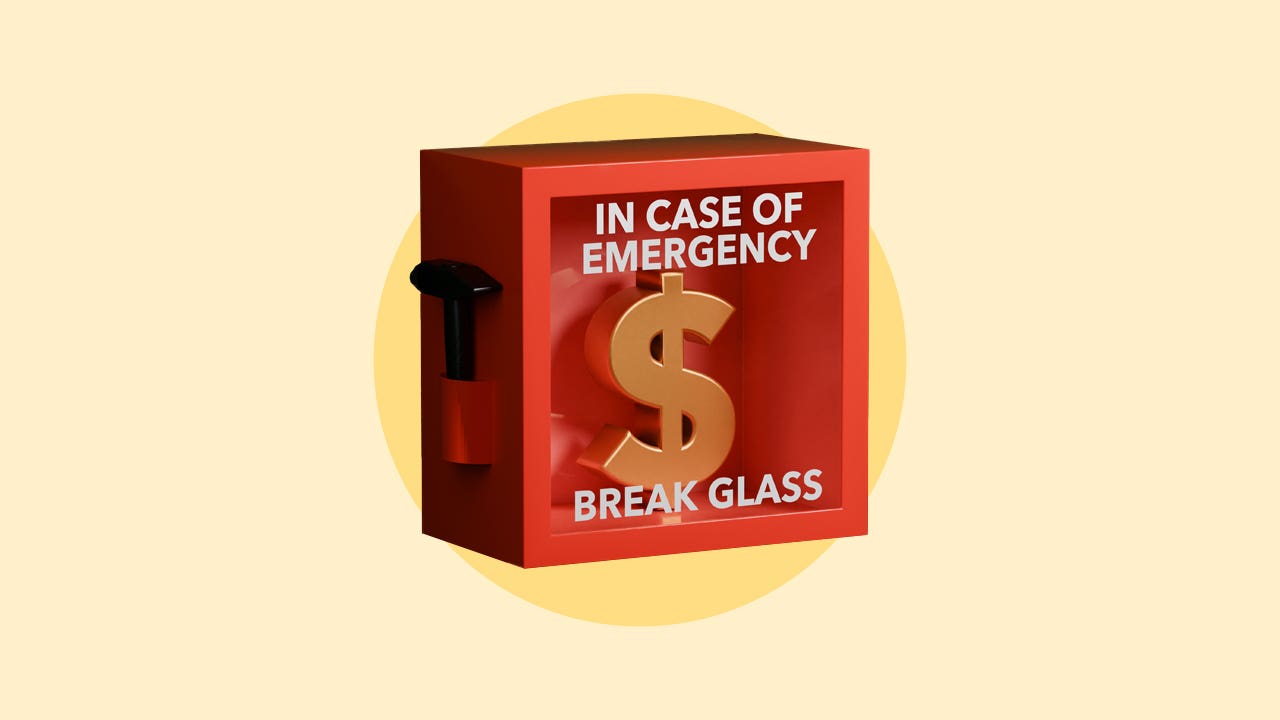How to get an emergency loan in 5 simple steps

Key takeaways
- You can get funds within one business day with some types of emergency loans.
- Payday loans or car title loans may be your only emergency loan choice if you can’t qualify based on your credit.
- Even if you’re in a hurry, make sure you compare each lender and loan option to make sure you’re getting the best rate and terms for your credit situation.
Getting an emergency loan can be as easy as filling out an online application, providing details about your paycheck and adding bank information.
Emergency personal loans can give you quick cash to pay for the unexpected. They are a type of personal loan that borrowers can use for a crisis, such as medical bills or important home repairs. They tend to be small and are funded within days.
If you need money urgently but don’t have the cash to cover it, you’re not alone. The 2024 Bankrate Emergency Savings report found that over half of U.S. adults (56 percent) wouldn’t pay for an emergency expense of $1,000 or more from their savings account.
Knowing how to get different types of emergency loans and comparing emergency loan rates may help you find the right one in a bind.
How to get an emergency loan
The need for immediate funds can make it difficult to make an informed loan decision. You may be dealing with doctors in a hospital emergency or insurance companies after a car accident.
Regardless of the circumstances, there are five steps you can take to help you choose the right emergency loan for you.
1. Decide if you need an emergency loan
Consider your timeline for needing the funds. Some situations require fast emergency cash. But perhaps you have time to plan for your dental work, or your insurance covers a rental while your car is being repaired. If you have at least a few days before you need money, it gives you time to shop around. You may find better rates and terms.
2. Compare loan types and lenders
Always compare rates and terms offered by at least three different companies. The right emergency lender depends on your financial situation and how quickly you need the money.
Several types of emergency loans are available. Each has its pros and cons, and some may better fit your situation and finances than others.
If you need money within a day or two to fund your emergency, personal loans, payday loans, credit card cash advances and title loans offer the fastest cash. Of those options, personal loans have the lowest costs and fewest drawbacks.
Watch out for predatory features like prepayment penalties, upfront fees or high interest rates. Fees on payday loans may translate to annual percentage rates (APRs) above 600 percent. If you feel pressured to accept a lender’s offer or don’t understand the loan terms, find another lender.
3. Get prequalified
Most emergency lenders prequalify you based on the information you provide them when you start shopping around. The key to getting the best loan for you will depend on several factors. Prequalification lets you preview rates without a hard credit inquiry. The key to getting the best loan for you will depend on several factors, including:
- Credit scores: Lenders use your credit score as a measure of risk for personal loans, home equity products and credit cards. If your credit score is below 670, you may need to shop for loans offered by fair credit and poor credit lenders. If you have no credit history, you may need to settle for a payday or title loan.
- Repayment terms: Choose the shortest repayment term you can comfortably afford so a one-time emergency doesn’t turn into a long-term debt payment that costs you a fortune in interest.
- Interest rates: When shopping for an emergency loan, pay close attention to APR. It includes both interest and fees. You can use the APR to calculate your payment and your total interest cost.
Pick an emergency loan payment that fits into your budget. Consider a longer term if you’re already living paycheck to paycheck. You can usually pay the balance down faster if you have the extra funds available in the future.
4. Fill out the application
Once you pick the best emergency loan lender, you must complete an application and provide any documents needed once approved. You may need documents like pay stubs, proof of address and your driver’s license for a personal loan.
A new HELOC or home equity loan may require the same documents you needed when you bought your home, including assets, tax returns and possibly even a home appraisal. Provide documents as quickly as possible to get your cash in the shortest amount of time.
5. Wait for a decision and funding
The time to get your decision and funding will depend on the type of loan you take out. Funding is usually directly deposited into your bank account with automatic payments set up for future payments.
| Loan type | Time to funding |
| Personal loan, payday loan, title loan | 1-7 business days |
| Credit card cash advance | Instant |
| Home equity loan, HELOC | Up to 45 days |
Where to get a fast emergency loan
A number of financial institutions offer fast emergency loans. The right one for you may vary depending on when, where, and how your emergency situation occurs.
Best options
Banks
Your local bank may offer you an emergency loan at more competitive rates and better terms if you have a longstanding relationship.
The main benefit of borrowing from a bank is knowing who you’re borrowing from in a face-to-face setting. They may offer financial advice so you don’t need to borrow money for emergencies in the future.
If you have bad credit, banks may not be willing to lend you money. They tend to set more stringent credit requirements.
Credit unions
Like banks, credit unions typically offer you fair terms and interest rates on the money you borrow. They may also offer fast turnaround times for HELOCs and home equity loans.
Credit unions may be a better option than banks for those with less-than-perfect credit. They tend to have more lenient credit and income requirements.
Like banks, funding timelines may be longer than online lenders. Additionally, you’ll need to be a member to apply. Applying for membership could delay access to the funds you need in a crunch.
Online lenders
Securing an emergency personal loan online is fairly simple and requires you to fill out some personal information from the comfort of your home. Taking out your loan online will also allow you to compare different loan options all at once, and they may be available during hours when most banks are closed.
Online lenders offer speedy funding, and you could get up to seven years to pay the loan off. You could also get a competitive interest rate if you have a solid credit score, but a lower rating isn’t necessarily a deal-breaker. For these reasons, if you are in a precarious financial situation and need money as soon as possible, an online lender is your best bet.
Scammers may pose as online lenders. Always check that a lender is legitimate and registered in your state. Make sure the lender’s website is secure, too.
Last resort
Payday lenders
You can find payday lenders online or in local strip malls in most areas. The applications usually only require proof of employment and how often you’re paid.
These loans come with APRs in the triple digits and high fees that are difficult to understand. Plus, payment is typically required in 14 days, which can further strain your finances. So, they should only be considered if you can’t qualify for a bad credit personal loan and cannot borrow funds from friends or family.
Many states restrict this type of lending. It often hurts more people than it helps. If this no-credit loan is the only way you can pay an urgent expense, do everything possible to pay it off when it’s due and search for other funding options when your circumstances aren’t as dire.
Car title lenders
Like payday loans, car title loans don’t require a credit check. You can get the funds quickly with basic information about your vehicle. However, these loans tend to have extremely high interest rates and fees.
Before pursuing this route, exhaust all other options, including borrowing money from friends or family. Car title loans’ high interest rates and short repayment terms increase your chances of failing to repay. If you default, your car could be repossessed.
The bottom line
Getting an emergency loan can provide financial relief in times of crisis. You can take five simple steps to secure an emergency personal loan. Carefully consider your options and compare lenders to ensure you get the best rates and terms. Only borrow what you need and have a repayment plan in place.
By taking these steps, you can be prepared for any unexpected costs and avoid falling into a cycle of debt. If you are not currently in crisis, work to build an emergency fund so you don’t need to borrow when life happens.
Why we ask for feedback Your feedback helps us improve our content and services. It takes less than a minute to complete.
Your responses are anonymous and will only be used for improving our website.
You may also like

How To Get A $100,000 Personal Loan: Top Tips

How to get a $50,000 personal loan: Try these lenders

How a personal loan can help you after a natural disaster

4 ways to get an emergency loan with bad credit



